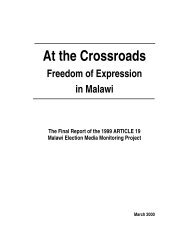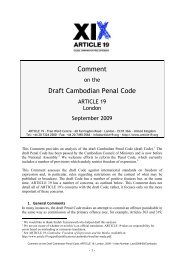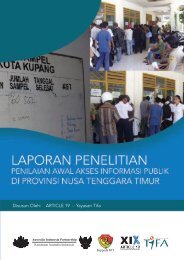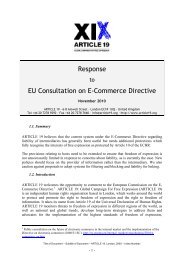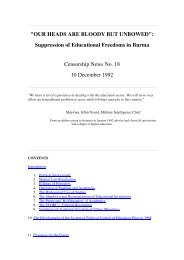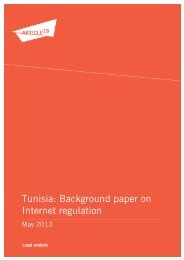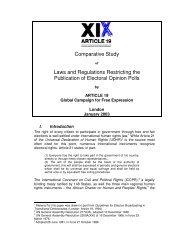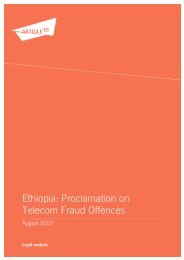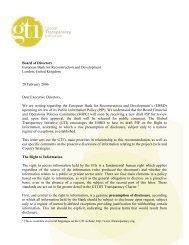Response to DPP Social Media Consultation - Article 19
Response to DPP Social Media Consultation - Article 19
Response to DPP Social Media Consultation - Article 19
Create successful ePaper yourself
Turn your PDF publications into a flip-book with our unique Google optimized e-Paper software.
The consultation processANNEX AThe purpose of this consultation is <strong>to</strong> seek a range of views on the InterimGuidelines on prosecuting cases involving communications sent via <strong>Social</strong><strong>Media</strong>.We welcome your comments by no later than 13 March 2013.Questions for consultationWe have identified a number of questions which are outlined at the end of the<strong>Consultation</strong> Paper on which we would particularly invite comment.If you are replying by email, we should be grateful if you would not attach anyother documents <strong>to</strong> the consultation paper. There are limits on the size ofdocuments that we are able <strong>to</strong> accept and any completed consultationdocument which has an attachment runs the risk of not being delivered. If youwish <strong>to</strong> send an attachment <strong>to</strong> us, please email us separately atsocialmedia.consultation@cps.gsi.gov.uk.If you use a special software program <strong>to</strong> read the <strong>Consultation</strong> Document andyou find that you have difficulty in reading it, please get in <strong>to</strong>uch with theTeam whose contact details are set out in the How <strong>to</strong> Respond section.If you would like <strong>to</strong> return your replies <strong>to</strong> the question at the back of the<strong>Consultation</strong> Document by post, please download the Interim Guidelines inPDF format.Alternatively, you can read the draft Interim Guidelines on the CPS website.How <strong>to</strong> respondBoth written and electronic responses <strong>to</strong> the consultation are acceptable,although we would prefer electronic replies on the completed pro-forma.1
Please be aware that if you complete and return this document by email, youwill be responding over the open internet. If you would prefer, pleasecomplete and return the PDF version <strong>to</strong> the postal address given below.Please include your name, organisation (if applicable), postal address andemail address.Closing date for responses: 13 March 2013<strong>Response</strong>s can be sent by post <strong>to</strong>:Interim Guidelines on <strong>Social</strong> <strong>Media</strong> <strong>Consultation</strong> TeamStrategy and Policy Direc<strong>to</strong>rateCrown Prosecution Service9th FloorRose CourtSouthwark BridgeSE1 9HSor by email <strong>to</strong>: socialmedia.consultation@cps.gsi.gov.ukWelsh language documentsThe following consultation documents are available in Welsh language:• Download the consultation document on interim guidelines onprosecuting cases involving communications sent via social mediaconsultation document in Welsh (Adobe PDF document - 230kb)• Dadlwythwch y ddogfen ymgynghori ynglŷn â cyfarwyddiadau interimErlyn achosion sydd yn gysylltiedig a chyfryngau cymdeithasu (DogfenPDF Adobe 79kb)• Download the consultation response document in Welsh (MicrosoftWord file, 34kb).• Dadlwythwch y ddogfen ymateb Gymraeg ynglŷn â'r ymgynghoriad(Dogfen Microsoft Word – 71kb)2
Alternative formatsIf you require a copy of this <strong>Consultation</strong> Paper in any other format, forexample, audio or large print, please contact the postal address above.Next stepsWe will consider every individual response received. A summary of theconsultation responses will be published on the CPS website in accordancewith the Government's guidelines.<strong>Response</strong>s: Confidentiality and disclaimerThe information you send us may be passed <strong>to</strong> colleagues within the CPS,the Government or related agencies. Furthermore, information provided inresponse <strong>to</strong> this consultation, including personal information, may bepublished or disclosed in accordance with the access <strong>to</strong> information legislationincluding the Freedom of Information Act 2000 (FOIA).If you want the information that you provide <strong>to</strong> be treated as confidential,please be aware that, under FOIA, there is a statu<strong>to</strong>ry Code of Practice withwhich public authorities must comply and which deals, amongst other things,with obligations of confidence. In view of this it would be helpful if you couldbriefly explain <strong>to</strong> us why you regard the information you have provided asconfidential. If we receive a request for disclosure of the information we willtake full account of your explanation, but we cannot give an assurance thatconfidentiality can be maintained in all circumstances. An au<strong>to</strong>maticconfidentiality disclaimer generated by your IT system will not be regarded asbinding on the CPS.Please ensure your response is marked clearly if you wish your response andname <strong>to</strong> be kept confidential. Confidential responses will be included in anystatistical summary of numbers of comments received and views expressed.The CPS will process your personal data in accordance with the DataProtection Act <strong>19</strong>98 - in the majority of circumstances this will mean that yourpersonal data will not be disclosed <strong>to</strong> third parties.3
Government <strong>Consultation</strong> PrinciplesThe key <strong>Consultation</strong> Principles are:• departments will follow a range of timescales rather than defaulting <strong>to</strong> a12-week period, particularly where extensive engagement hasoccurred before;• departments will need <strong>to</strong> give more thought <strong>to</strong> how they engage withand consult with those who are affected;• consultation should be 'digital by default', but other forms should beused where these are needed <strong>to</strong> reach the groups affected by a policy;and• the principles of the Compact between government and the voluntaryand community sec<strong>to</strong>r will continue <strong>to</strong> be respected.The complete <strong>Consultation</strong> Principles are available from the Cabinet Officewebsite.4
<strong>Response</strong> Pro FormaWhen responding it would helpful if you would complete this pro forma.Please fill out your name and address or that of your organisation if relevant.You may withhold these details if you wish but we will be unable <strong>to</strong> includeyou in future consultation exercises.<strong>Response</strong> SheetContact details:Please supply details of who has completed this response.<strong>Response</strong> completed by (name):Gabrielle GuilleminPosition in organisation (if appropriate):Legal OfficerName of organisation (if appropriate): ARTICLE <strong>19</strong>Address:60 Farringdon RoadLondon EC1 3GAContact phone number: 020 7324 2513Contact e-mail address:gabrielle@article<strong>19</strong>.orgDate: 12/03/20135
Please answer the consultation questions in the boxes below.1. Do you agree with the approach set out in paragraph 12 <strong>to</strong> initiallyassessing offences which may have been committed using social media?ARTICLE <strong>19</strong> generally welcomes the <strong>DPP</strong>’s guidelines, which provide a greater degree of clarity andpredictability regarding the prosecution of offences involving social media. In particular, the decision<strong>to</strong> prioritise the prosecution of credible threats of violence (category 1) and harassment (category 2)is both sensible and uncontroversial. In this regard, we also support the guidelines’ approach whichmakes clear that as a rule, these types of cases should be prosecuted under the Offences Against thePerson Act 1861 or the Protection from Harassment Act <strong>19</strong>97, rather than the Communications Act2003.We note, however, that the guidelines could be further improved by clarifying that bullying online isnot as such a criminal offence although it may amount <strong>to</strong> an offence under the 1861 Act or the<strong>19</strong>97 Act provided the relevant threshold is met. We also note that further clarity would also behelpful in relation <strong>to</strong> the question of who "may reasonably expected <strong>to</strong> see" a message within the tes<strong>to</strong>f 'menacing character' set out by the Lord Chief Justice in Chambers v <strong>DPP</strong> [2012] EWHC 2157(Admin) at para 30, since a message sent or posted <strong>to</strong> a select audience may very easily be reposted,linked or forwarded <strong>to</strong> the world at large. The guidelines should stress the importance of takingaccount of the initial context in which a message was sent, including the reasonable expectation ofthe original author that his or her message should only be read by the audience he or she intended.Despite the generally positive features identified above, we also remain concerned that theguidelines concerning grossly offensive, indecent, obscene or false communications (category 4) areinsufficiently detailed <strong>to</strong> help social media users determine whether they may be at risk ofprosecutions for comments made on social media sites (See question 2).2. Do you agree with the threshold in bringing a prosecution under section127 of the Communications Act 2003 or section 1 of the MaliciousCommunications Act <strong>19</strong>88?At the outset, ARTICLE <strong>19</strong> would emphasise that both Section 127 of the Communications Act2003 and Section 1 of the Malicious Communications Act <strong>19</strong>88 are drafted in extremely broadterms. It is therefore highly questionable that they meet the requirement of legal certainty underARTICLE 10 European Convention on Human Rights (ECHR) and <strong>Article</strong> <strong>19</strong> of the InternationalCovenant on Civil and Political Rights (ICCPR). As the European Court has repeatedly emphasised, itis not sufficient for an interference with the right <strong>to</strong> freedom of expression <strong>to</strong> have a basis indomestic law. The law itself must correspond <strong>to</strong> certain requirements of “quality”. In this regard theCourt has said that:‘A particular, a norm cannot be regarded as a “law” unless it is formulated with sufficient precision<strong>to</strong> enable the citizen <strong>to</strong> regulate his conduct: he must be able – if need be with appropriate advice –<strong>to</strong> foresee, <strong>to</strong> a degree that is reasonable in the circumstances, the consequences which a givenaction may entail’ (see, for example, Lindon, Otchakovsky-Laurens and July v. France [GC], nos.21279/02 and 36448/02, § 41, ECHR 2007‐XI).Accordingly, ARTICLE <strong>19</strong> believes that the better approach would be for prosecu<strong>to</strong>rs not <strong>to</strong> rely onthe above provisions. There is nothing exceptional about not enforcing criminal laws on the statutebook where it is not in the public interest <strong>to</strong> do so: see e.g. Lord Scott in R v At<strong>to</strong>rney General ex6
parte Rusbridger [2003] UKHL 38 at para 40: "No At<strong>to</strong>rney General or Direc<strong>to</strong>r of PublicProsecutions would or could authorise a prosecution [under section 3 of the Treason Felony Act1848] for [peacefully advocating the abolition of the monarchy] without becoming a laughing s<strong>to</strong>ck".Similarly, when Parliament considered whether or not <strong>to</strong> abolish the offence of blasphemy, it wasnoted that there had not been a public prosecution for blasphemy since <strong>19</strong>22 (see House ofCommons Library, The Abolition of Blasphemy Offences, SN/PC/04597, 9 May 2008, at page 18).The Criminal Justice and Immigration Act 2008 subsequently abolished the offence of blasphemy in2008. Similarly, there were very few prosecutions in the last century for sedition until the offencewas abolished in 2010 (see Hansard, 9 july 2009, Column 844).If, contrary <strong>to</strong> our recommendation, prosecu<strong>to</strong>rs continue <strong>to</strong> enforce the above provisions, ARTICLE<strong>19</strong> agrees that the threshold for such prosecutions should be a very high one. While the explanationcontained in paragraphs 30 <strong>to</strong> 36 goes some way <strong>to</strong>wards clarifying what that may entail, we remainconcerned that: (1) ‘grossly offensive’, ‘indecent’ and ‘obscene’ are eminently subjective terms whichcan be interpreted in any number of different ways; and (2) it is equally unclear what “more than”grossly offensive, obscene etc means. In other words, the threshold for category 4 communicationsprosecution still lacks foreseeability.It would therefore be helpful if the guidance could provide practical examples of the types ofcircumstances in which a social media user may be prosecuted for category 4-types ofcommunications. We further draw attention <strong>to</strong> the Twitter Help Centre’s guidance on offensivecomments, which provides further additional elements that prosecu<strong>to</strong>rs should consider whenexamining category 4-type of communications, such as the timeline of tweets:https://support.twitter.com/articles/20170133-offensive-content-consider-the-context.3. Do you agree with the public interest fac<strong>to</strong>rs set out in paragraph 39?ARTICLE <strong>19</strong> welcomes the attempt <strong>to</strong> identify circumstances in which a prosecution is unlikely <strong>to</strong> benecessary and proportionate. We broadly support the public interest fac<strong>to</strong>rs set out in paragraph 39.We do, however, have serious reservations about criteria 39 (a) and (b), which in our view could havean inadvertent chilling effect on freedom of expression. In particular, criterion 39 (a) couldencourage self-censorship of social media users as long as it remains unclear what ‘more than’grossly offensive, obscene etc. communications means. The law should not give incentives <strong>to</strong> people<strong>to</strong> apologise or retract what they may legitimately express under the law.Similarly, criterion 39 (b) could have the effect of encouraging service providers such as Facebook <strong>to</strong>remove perfectly legitimate - albeit distasteful - comments, when they feel there may be a risk ofprosecution against their users. This is particularly important given that intermediaries are likely <strong>to</strong>be the first port of call for any complaint or enforcement action. It is also unclear how such ‘swiftand effective action’ would take place. In particular, we are concerned that this may be interpretedas giving a licence <strong>to</strong> police and prosecu<strong>to</strong>rs <strong>to</strong> request intermediaries and social media platforms(such as Facebook or Twitter) <strong>to</strong> remove communications which are distasteful or obnoxious but fallbelow the threshold for prosecution.In relation <strong>to</strong> criterion 39(c), while we strongly support the general thrust of this provision, theconcept of an 'obvious consequence of sending the communication' is problematic. As we noted inour answer <strong>to</strong> question 1, the nature of modern communications makes it very easily <strong>to</strong> link, forwardor repost messages intended for a narrow audience <strong>to</strong> the world at large. To impose criminalsanctions upon the original author of a message on this basis alone would, in our view, breach both7
<strong>Article</strong>s 8 and 10 ECHR and <strong>Article</strong> <strong>19</strong> of the ICCPR.Finally, we wonder whether it is necessary <strong>to</strong> include the consideration at paragraph 39(d) that “thecontent of the communication did not obviously go beyond what could conceivably be <strong>to</strong>lerable oraccepted in an open or diverse society which upholds and respects freedom of expression.” We cansee the benefit of including a public interest fac<strong>to</strong>r, which reinforces the high threshold forprosecution. On the other hand we consider that the relationship between this fac<strong>to</strong>r and the “morethan” threshold test might be unclear <strong>to</strong> prosecu<strong>to</strong>rs and police. Disagreement and inconsistencycould arise if some relied on the test of whether the comment was “more than offensive, shocking ordisturbing...” and others relied instead on the test of whether the comment “obviously goes beyondwhat could be conceivably <strong>to</strong>lerable or acceptable in an open and diverse society etc.”4. Are there any other public interest fac<strong>to</strong>rs that you think should also beincluded?In determining whether a prosecution is both necessary and proportionate, ARTICLE <strong>19</strong> fullysupports the additional fac<strong>to</strong>rs identified by Alex Bailin QC and Edward Craven on the Inforrm blog,namely:• Whether the message is intended <strong>to</strong> be humorous: we consider that it is necessary <strong>to</strong> take thisfac<strong>to</strong>r in<strong>to</strong> account <strong>to</strong> ensure that prosecutions such as that in the ‘twitter joke trial’ of PaulChambers v <strong>DPP</strong> do not take place in future. This fac<strong>to</strong>r has moreover been taken in<strong>to</strong>account in the case law of the European Court of Human Rights. In Nikowitz v VerlagsgruppeNews GmbH v Austria, 1 the Court gave consideration <strong>to</strong> whether the statement “remainswithin the limits of acceptable satirical comment in a democratic society” (paragraphs 25-26).• Whether it is a first time offence: a prosecution is more likely <strong>to</strong> be in the public interest ifthe suspect has already been convicted for sending communications of a similar nature in thepast. In the vast majority of cases, a warning would be more appropriate.• Whether there are concurrent civil proceedings being brought: this is consistent with theapproach of the European Court of Human Rights. In Raichinov v Bulgaria, 2 for example, theCourt noted that “the assessment of the proportionality of an interference with (<strong>Article</strong> 10)will in many cases depend on whether the authorities could have resorted <strong>to</strong> means otherthan a criminal penalty, such as civil and disciplinary remedies” (para 50).5. Do you have any further comments on the interim policy on prosecutingcases involving social media?1 (no 5266/03, 22 Feb 2007) 2 No 47579/99, 20 April 2006 8
ARTICLE <strong>19</strong> supports the approach of the guidelines that comments sent via social media should notbe dealt with as public order cases since the Public Order Act was intended <strong>to</strong> deal with cases wherethe defendant and victim have interacted on a face <strong>to</strong> face basis.Similarly, we believe that the age and maturity of suspects are very important fac<strong>to</strong>rs, which shouldbe given significant weight in the context of social media communications.ARTICLE <strong>19</strong> further considers that due <strong>to</strong> the frequency of cross-jurisdictional communications viasocial media, the interim guidelines could usefully clarify this issue. Given the limited resources ofthe CPS, as a matter of practicality we conclude that communications via social media should onlybe prosecuted in the UK if both the defendant and the victim are within the UK.We would also welcome the development of a more coherent policy on sentencing for offencescommitted through social media. Much of the media attention regarding prosecutions forcommunications sent via social media has been focused on the inconsistency of the approach taken<strong>to</strong>wards sentencing. Cases which demonstrate this inconsistency in particular are the contrastbetween the case of Matthew Woods who in Oc<strong>to</strong>ber 2012 was sentenced <strong>to</strong> 12 weeks imprisonmentfor “jokes” on Facebook about missing 5 year old April Jones 3 with the case of Azhar Ahmed who inOc<strong>to</strong>ber 2012 was sentenced <strong>to</strong> 240 community service for posting a message on Facebook aboutthe deaths of soldiers, writing that “all soldiers should die and go <strong>to</strong> hell” 4 . These sentences alsostrongly contrast with the fine of £624 imposed on nine individuals who named and condemned arape victim on Twitter as “crying rape” and “money grabbing”. 5In particular, it might be useful for sentencing guidelines <strong>to</strong> address whether the public policyfac<strong>to</strong>rs in the interim guidelines, such as “whether the suspect has expressed genuine remorse”should also be taken in<strong>to</strong> account <strong>to</strong> affect the severity of sentencing. This might be useful <strong>to</strong>prosecu<strong>to</strong>rs who are used <strong>to</strong> taking in<strong>to</strong> account this fac<strong>to</strong>r at the sentencing stage in other criminalcontexts.3 http://www.mirror.co.uk/news/april-‐jones-‐man-‐charged-‐over-‐1365779. 4 http://www.bbc.co.uk/news/uk-‐england-‐leeds-‐<strong>19</strong>883828 5 http://www.bbc.co.uk/news/uk-‐wales-‐north-‐east-‐wales-‐20207408 9



